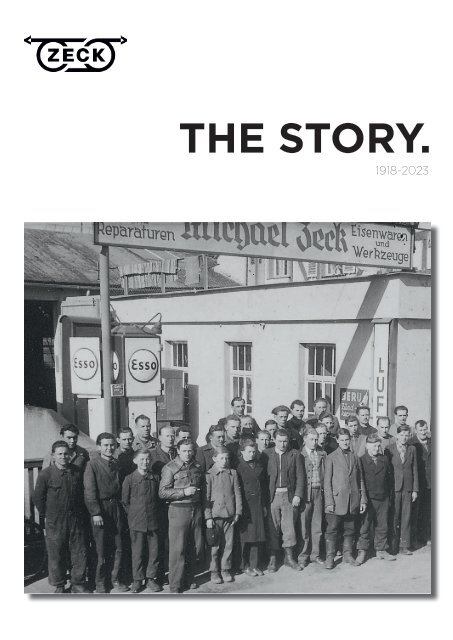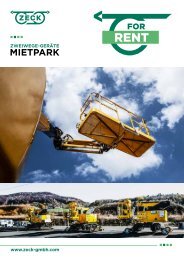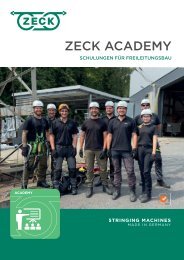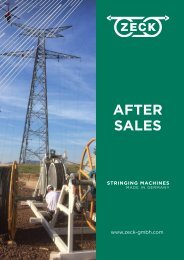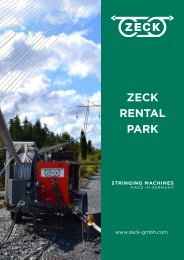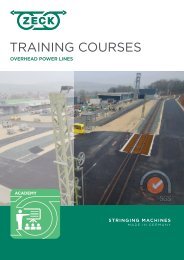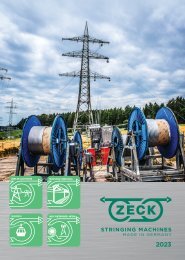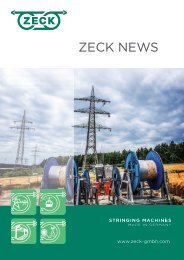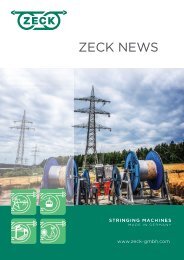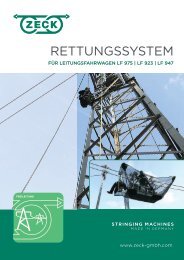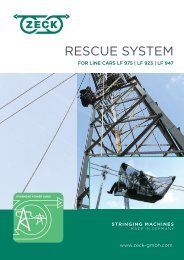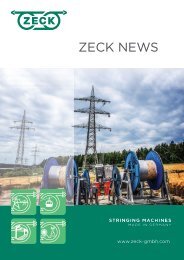ZECK - THE STORY
1918 - 2023 The Company Chronicle for the 105th Anniversary.
1918 - 2023 The Company Chronicle for the 105th Anniversary.
Create successful ePaper yourself
Turn your PDF publications into a flip-book with our unique Google optimized e-Paper software.
<strong>THE</strong> <strong>STORY</strong>.<br />
1918-2023
2
PREFACE.<br />
PREFACE<br />
It was in the late autumn of 1918 when Michael Zeck (1891-1967) went<br />
into business for himself, opened a locksmith's store and specialized in<br />
mechanical engineering. With this step and his courage to take entrepreneurial<br />
risks, he laid the foundation for today's company, the pioneer<br />
and world market leader in the field of transmission line construction<br />
and the development and production of the special machines required.<br />
The first century of <strong>ZECK</strong> was worthily celebrated in October 2018.<br />
Within the scope of the celebrations at that time, the idea arose to record<br />
the results and milestones of <strong>ZECK</strong>'s corporate history in a chronicle.<br />
After senior boss Fritz Zeck (2nd generation) was called away to<br />
eternity on February 19, 2021, at the age of 91 after a long and full life,<br />
where he was followed by his wife Gisela on March 23, 2021 - less than<br />
five weeks later - this chronicle is to be dedicated in a special way to<br />
the memory of both of them.<br />
Tension since 1918 - A journey.<br />
Of great importance, therefore, are the conversations held in 2018 in<br />
preparation for the anniversary with Fritz Zeck, whose experiences will<br />
find their place here. It is also his anecdotes that impressively reflect<br />
the spirit of <strong>ZECK</strong> and are worth passing down and preserving. This<br />
chronicle reveals how these stories became a story of success.<br />
It is also a tribute to all the employees who, day after day, give their<br />
best to move the company forward, who contribute their talents to<br />
meet customer needs; but it is also a tribute to all the partners and<br />
customers who, through their trust, have contributed to making this<br />
company what it is today - a symbol of excellence, progress, and innovation.<br />
They are all part of the whole; they are all part of the <strong>ZECK</strong><br />
history of success.<br />
This chronicle is a journey that leads through crucial milestones, challenges<br />
and triumphs, documenting at each stage the growth and<br />
3
THREE GENERATIONS.<br />
transformation of a vision into reality. It reflects the evolution that the company has undergone over<br />
time. From a small local company to a global leader, each step opened a new door to increase the<br />
impact and range of the company. New technologies were introduced, modern production methods<br />
were developed, and strategic partnerships were formed - all of which helped the company to<br />
grow and prosper. We invite you to explore this chronicle of the company's history and be inspired<br />
by its history and success. Immerse yourself in a world of innovation, passion, and perseverance.<br />
THREE GENERATIONS OF ENTREPRENEURS<br />
Michael Zeck<br />
1891-1967<br />
Fritz Zeck<br />
1929-2021<br />
Michael Zeck<br />
*1966<br />
Three generations of entrepreneurs have shaped <strong>ZECK</strong>, each in their own way. Each generation<br />
brings its unique skills, perspectives, and innovations, leaving its mark on the company's development<br />
and success. The first generation with Michael Zeck (1891-1967) laid the foundation for the<br />
company. With pioneering and entrepreneurial spirit, he led the company through the challenges<br />
and uncertainties of the early days. Through hard work, risk-taking and an unwavering vision, the<br />
foundation was laid on which the company could build.<br />
The second generation with Fritz Zeck (1929-2021) followed in the founder's footsteps and brought<br />
in new ideas and strategies. With a fresh look at the market and innovations<br />
4
LOCATION.<br />
in technology, production, or sales, he contributed to developing the company and taking it to new<br />
levels. He built on the experience of the first generation but set new impulses to stay on the road to<br />
success and keep the company competitive.<br />
The third generation with Michael Zeck (*1966) is characterized by new challenges and a constantly<br />
changing business environment. Michael Zeck brings modern ideas, technologies, and digital strategies<br />
to lead the company into the future. He is responsible for ensuring that the company meets<br />
current trends and requirements.<br />
Thus, each generation of <strong>ZECK</strong> has played its part in shaping the company's culture and driving its<br />
success. This chronicle captures the history and achievements of each generation and shows how<br />
the company has grown because of these individual contributions.<br />
ONCE ALMOST RAILWAY STATION - <strong>THE</strong> LOCATION<br />
The story of <strong>ZECK</strong> begins in 1918, the fateful year in German<br />
history after the First World War. However, it is first<br />
worth taking a look at the company's current location,<br />
which is itself historical ground in many respects. This<br />
does not refer to the more than 1,200-year history of<br />
the town of Schesslitz, beginning with the first mention<br />
around the year 805, or even to the 6,500-year-old evidence<br />
of early settlements from the early Neolithic period,<br />
but rather to the fact that tracks were once to be<br />
laid precisely on today's <strong>ZECK</strong> testing site for specialized<br />
rail vehicles, namely the extension of the railroad from<br />
Schesslitz to Hollfeld.<br />
Transport connection of Schesslitz in 1912<br />
On September 30, 1908, the Bamberg-Schesslitz railroad<br />
line was inaugurated. Under cannon salute and accompanied<br />
by marching music, the first train arrived at<br />
Schesslitz station at 11:26 am. Thus, Schesslitz was connected<br />
to the Bavarian railroad network. It is said that<br />
during the reception on the station square, the festively<br />
decorated honorary stand made of light boards collapsed<br />
with the guests of honor - just at the moment<br />
when the mayor had begun his festive speech. This led<br />
5
1918.<br />
to tumultuous scenes, which the priest was able to end with the blessing of the locomotive and<br />
wagon.<br />
However, Schesslitz was not to remain the final destination. Plans to continue the railroad to Hollfeld<br />
and thus ensure the connection to Bayreuth date back to 1894. Spurred on by iron ore discoveries in<br />
the Jura, the project was pursued further with different route layouts. One option was to go directly<br />
past Burgellern and across the testing grounds to Stadelhofen.<br />
Many communities fought for a direct connection to the railroad line. After the First World War, the<br />
idea of continuing the project was discussed once again, but then shelved by the Reich Ministry of<br />
Transport in view of the poor economic situation and the shortage of building materials.<br />
<strong>THE</strong> SETTING IN <strong>THE</strong> FOUNDING YEAR 1918:<br />
LOST WAR, FAMINE AND PANDEMIC<br />
Exactly in this time, the company <strong>ZECK</strong> was founded. The First World War from 1914 to 1918 was<br />
the first war of industrialized powers among and against each other. All the inventions and achievements<br />
of industrialization were put to use, including machine guns, tanks, and poison gas. Almost<br />
20 million dead were the result, although there was no fighting at all on German soil in the homeland<br />
if you will. On the home front, the advancing duration of the war, due to the Allied naval blockade,<br />
the lack of supplies from Russia, and crop failures, meant increasingly severe cuts in daily life<br />
due to strict food rationing. Food became scarce, although rural areas were not affected to the<br />
same extent as cities.<br />
The winter of 1916/17 and the famine that accompanied it went down in history as Turnip Winter. In<br />
total, about 800,000 people died of hunger and malnutrition in Germany from 1914 to 1918. People's<br />
health suffered additionally because, due to the rationing of soap to 50 g per month, personal hygiene<br />
was only possible to a limited extent; 50 g of a soap that had a fat content of only 20 percent,<br />
contained fillers such as clay and soapstone, and could only be obtained through soap cards.<br />
From the spring of 1918, a pandemic in the form of the so-called Spanish flu was added, which in<br />
three waves up to 1920 claimed at least 25 million, and according to a balance sheet published in<br />
the Bulletin of the History of Medicine in the spring of 2002, even almost 50 million lives, and is<br />
comparable to the great plague wave of 1348, which at that time claimed the lives of more than<br />
a third of the European population. A peculiarity of the Spanish flu was that it was mainly 20- to<br />
40-year-old people who succumbed to it.<br />
6
FREISTAAT BAYERN.<br />
Food stamps for flour and bread from the year 1917<br />
After the war was de facto lost from the German point of view, the German High Seas Fleet was to<br />
sail out for a final battle against the British Royal Navy by fleet order of the Naval War Command<br />
on October 24, 1918, despite Germany's already determined defeat in the war. The mutiny of some<br />
ship's crews in Kiel and Wilhelmshaven, which resulted in a sailors' revolt, was directed against this<br />
absurd plan. This, in turn, developed within a few days into a revolution that swept the entire empire.<br />
END OF <strong>THE</strong> MONARCHY - BAVARIA BECOMES A FREE STATE<br />
The revolution led to the proclamation of the Republic in Berlin on November 9, 1918. The abdications<br />
of Kaiser Wilhelm II and all other monarchs of the German principalities followed shortly<br />
thereafter. In Munich, Bavarian King Ludwig III had already been declared deposed on November<br />
7. This ended the rule of the Wittelsbach dynasty, which had ruled Bavaria since 1180. In the first<br />
hour of November 8, 1918, Kurt Eisner of the Independent Social Democrats had proclaimed the<br />
"Free State of Bavaria". Political unrest increased significantly in the period that followed. After the<br />
assassination of the first Minister President Kurt Eisner on February 21, 1919, the government under<br />
Johannes Hoffmann fled with the state parliament to Bamberg and worked here on a constitution<br />
for the Free State of Bavaria, which was adopted on August 14, 1919, and went down in the history<br />
books as the "Bamberg Constitution". That was the political setting, the framework in which Michael<br />
Zeck founded his company, well, started his business.<br />
7
MICHAEL <strong>ZECK</strong>.<br />
ABOUT <strong>THE</strong> ROOTS:<br />
<strong>THE</strong> FOUNDER MICHAEL <strong>ZECK</strong><br />
Michael Zeck was born on January 21, 1891, in Kremmeldorf near Bamberg, which has been a district<br />
of Memmelsdorf since the 1972 municipal area reform. His parents were Bernhard and Kunigunde<br />
Zeck, née Einwich. By profession, Michael's parents were "brickyard owners' couple" and farmers.<br />
Records of Michael Zeck's life are unfortunately very sparse. Neither in the family archives nor in the<br />
city archives of Schesslitz nor in the state archives of Bamberg much information has been found.<br />
He was probably already a "hidden champion" back then.<br />
LABOR PERFORMANCE ON <strong>THE</strong> PARENTAL FARM<br />
The War Archives in Munich hold the muster rolls of soldiers who were called up and registered by<br />
the military in Bavaria during the First World War. In volume 19.674, the 13th volume of the Bavarian<br />
War Rolls, our Michael Zeck can be found. The files show that as a recruit he formally belonged to<br />
the “Train Supply Unit Würzburg 2, Bamberg District Command”. "Train" means military transportation<br />
and column, i.e., logistics of material. This had developed in the course of the war of position<br />
on the western front to France and the months of material battles.<br />
On March 31, 1918, Michael Zeck was deputized to Kremmeldorf as "permanently at the parental farm<br />
to perform labor on the parental farm" and deferred until August 31, 1918. This means that during<br />
this time he did not have to actively fight with weapons. The supply of food to the population, i.e.,<br />
the "food battle" on the home front, had meanwhile become the decisive question of survival.<br />
8<br />
Eintrag von Michael Zeck in der<br />
Kriegsstammrolle (Auszug)
FOUNDATION.<br />
LOCKSMITH BY PROFESSION:<br />
ALL-ROUNDER IN METALWORKING<br />
From the record in the war archive it can be seen that Michael Zeck was a locksmith by training and<br />
profession. Locksmiths were and are all-rounders in metalworking - from artistic design of gates<br />
and fences to mechanical engineering. Michael Zeck developed a keen interest in machinery and<br />
technical design at an early stage. From the memories of Fritz Zeck, we know that his father Michael<br />
worked in the family brickyard and maintained the machines of the brickyard and the agriculture.<br />
This developed into a real passion for mechanical engineering. Fritz Zeck reported that his father<br />
was able to disassemble, analyze, rebuild, and even develop everything himself - right up to complete<br />
engines and his own designs. For example, Michael Zeck's brother had lost a leg in World War<br />
I, whereupon Michael built him a tricycle with a gasoline engine.<br />
<strong>THE</strong> FOUNDING DATE<br />
Unfortunately, no exact date beyond the founding year 1918 can be proven, because Michael Zeck,<br />
as a small businessman or self-employed craftsman, was not required to register in the commercial<br />
register at the district court. The trade roll of the city of Schesslitz, where it should be listed in turn,<br />
has been lost or destroyed. In addition, one must know that toward the end of the Second World<br />
War, when the Americans stood so to speak in Schesslitz before the door - after the memory of<br />
the archive keeper and former mayor Franz Zenk - large parts of the archives, in particular the time<br />
starting from 1900 concerning, were burned, because the politically responsible persons feared<br />
repressions because of affiliation to the NSDAP or to other NS organizations, which probably included<br />
nearly everyone.<br />
Since Michael Zeck had been deferred until August 31, 1918, and was no longer called up for military<br />
service, the official start of his activity was probably in the immediate aftermath,<br />
i.e., around September 1, 1918, or immediately after the end of the war and the proclamation of the<br />
Free State of Bavaria, i.e., in the third week of November (November 11-17) 1918.<br />
9
FROM KREMMELDORF TO SCHESSLITZ<br />
Michael Zeck's activity and further entrepreneurial growth developed harmoniously from his profession<br />
as a locksmith, initially offering his skills in machine maintenance to others. However, there<br />
was not enough space for this on the parents' estate. It was probably not centrally located enough,<br />
so he moved from the tiny village of Kremmeldorf with 30 houses to the town of Schesslitz, where<br />
he set up his business in a half-timbered house with three garage doors at Altenbach 19. There he<br />
remained for a decade.<br />
Michael Zeck did all the work for the house and yard, all the locksmith work that was needed in the<br />
rural area. From the 1920s, for example, these were:<br />
• Water supply<br />
• Water pumps<br />
• All kinds of installations<br />
• Setting up small gasoline and diesel engines<br />
• Transmissions for feed cutting machines, grist mills, etc.<br />
• Setting up generators<br />
This house Altenbach 19 still exists, it was later the origin of the Schesslitz car dealership Bärenstrauch<br />
and today houses a car repair shop.<br />
Fritz Zeck with his grandson Nikolas Weitz in October 2018<br />
10
Altenbach 19 – First operating location in Schesslitz until 1928<br />
11
INFLATION.<br />
<strong>THE</strong> INFLATION<br />
In the early 1920s, the German Empire's debt<br />
during World War I and the reparations subsequently<br />
stipulated in the Versailles Peace Treaty<br />
led to gigantic inflation. During this time, it was<br />
almost impossible to sell tangible assets, because<br />
you had to expect that the profit would<br />
immediately vanish into thin air. The municipalities<br />
issued emergency money in the form of<br />
vouchers so that the economy would not collapse<br />
completely.<br />
German Reichsbank bill for 1 million marks<br />
Inflation peaked in November 1923, when 1 dollar<br />
cost an astounding 4.2 trillion marks. For 1 liter<br />
of beer, 260 billion marks were due. During this<br />
period, trade in capital goods was not possible.<br />
It was not until the currency reform of November<br />
20, 1923, with the introduction of the Rentenmark<br />
and a radical cut by deleting 12 zeros (1<br />
trillion Reichsmarks to 1 Rentenmark) that conditions<br />
changed.<br />
Emergency money of the city of Bamberg for 50 billion marks<br />
<strong>THE</strong> TRADE IN MACHINES<br />
At the beginning of 1924, Michael Zeck started<br />
trading with agricultural machinery. For this year<br />
Michael Zeck was issued a trade card as a trader<br />
and commercial traveler for agricultural machinery<br />
by the district office of Bamberg. The register<br />
of "trade legitimation cards" lists him under<br />
number 171 with issue date February 29, 1924,<br />
and the business branch "trade in agricultural<br />
Issue of trade card for Michael Zeck 1924<br />
12
machinery & industrial machinery & equipment", for which a fee of 15 marks had to be paid. It is<br />
not uninteresting that Michael Zeck did not limit his line of business to agricultural machinery, but<br />
explicitly extended it to industrial machinery as well.<br />
AGRICULTURAL MACHINERY & MECHANICAL<br />
ENGINEERING FACILITY<br />
Nevertheless, agricultural machinery in particular, and<br />
not only trade, but also "customizing" with oxyacetylene<br />
welding, repair, maintenance, and overhaul in the midst of<br />
a very strongly agricultural environment between Bamberg<br />
and Bayreuth, formed the focus of Michael Zeck's<br />
activities, whose company stamp now identified the company<br />
as “mechanical engineering facility.”<br />
13
OBEREND 21.<br />
Harvesters and combines in particular became a<br />
specialty of Michael Zeck. In many villages around<br />
Schesslitz, farmers had joined together to operate a<br />
threshing machine. These threshing machines were<br />
maintained and repaired by Michael Zeck.<br />
<strong>THE</strong> GOLDEN TWENTIES:<br />
FROM ALTENBACH TO OBEREND<br />
Michael Zeck's business, with its broad portfolio of<br />
welding and repair work, its wide range of all kinds<br />
Example of a municipal / cooperative threshing machine as<br />
maintained by Michael Zeck<br />
of spare parts and its own workshop, flourished in terms of technology, machinery and agricultural<br />
equipment, his company had earned an excellent reputation in the area.<br />
However, the spatial conditions in Altenbach became increasingly cramped and could not be extended,<br />
which is why a new, larger location was sought and found at the address Oberend 21 on<br />
the main thoroughfare. At the turn of the year 1927/28, the company was relocated to Oberend<br />
and remained there for 65 years until the move to the new company building in Burgellern in 1993.<br />
65 years of head office: Oberend 21, Schesslitz<br />
14
TRIUMPHANT AUTOMOBILE MARCH<br />
The Golden Twenties of the 20th century also marked the<br />
triumphal march of the automobile. There was an immediate<br />
need here, not so much for dealers, because the car<br />
was an absolute luxury item, but for repairmen who also<br />
offered spare parts, accessories, and wear parts. Specifically,<br />
Schesslitz also lacked a gas station, which is why<br />
Michael Zeck had already applied for a concession in 1927,<br />
which was approved for him, who from then on also operated<br />
as "Car-Service Michael Zeck", on November 10, 1927.<br />
Information material of the "German American<br />
Petroleum Company" about brand and sign<br />
Two tanks were installed with a capacity of 3,000 liters<br />
and 2,000 liters, which is very modest from today's point<br />
of view. The supplier was the “German American Petroleum<br />
Company” based in Nuremberg, from which the<br />
ESSO brand later developed. There is also an exchange<br />
of correspondence concerning the approval of a "Pump"<br />
sign 500 meters away as an indication of the nearest gas<br />
station, in which the "German American Petroleum Company"<br />
endeavored to explain to the government of Upper<br />
Franconia the usefulness of the sign to the general public.<br />
OBEREND 21:<br />
"CAR SERVICE MICHAEL <strong>ZECK</strong>“<br />
Ladengeschäft im Oberend 21<br />
The new location proved to be a bull's eye due to its size,<br />
central location, in-house assembly areas and retail store:<br />
The store offered motorcycles, bicycles, tubes, coats, rims,<br />
sewing machines, as well as a lot of accessories, in addition<br />
to the agricultural machinery standing in the background.<br />
Werkstatt im Oberend 21<br />
A look into the workshop shows transmissions and belts<br />
on the ceiling, which were used to drive the locksmith's<br />
equipment for turning, milling, drilling and grinding. On the<br />
right in front is the OPEL "STRICH 16", with which senior<br />
boss Fritz Zeck learned to drive.<br />
15
In the "showroom" of the store behind the large display<br />
window, motorcycles, and bicycles (also racing<br />
bikes) were exhibited. MIELEWERKE from Gütersloh<br />
was known for very high-quality motorcycles and bicycles<br />
at that time.<br />
MIELE BASE<br />
„Showroom“ at Oberend 21<br />
However, Michael Zeck not only purchased bicycles<br />
from MIELEWERKE in Gütersloh, but also what the<br />
MIELE originally stood for: Special machines for agriculture,<br />
such as this butter kneader, which was advertised<br />
on a poster as "Michael Zeck, Maschinenhandlung,<br />
Schesslitz" with the lower half hidden in<br />
a picture frame. MIELE had already offered this immediately<br />
after its foundation in 1899 and developed<br />
the first washing machine from it.<br />
Butter kneader from MIELE in the assortment<br />
MARGARETE <strong>ZECK</strong> AND <strong>THE</strong><br />
STORE<br />
From the tradition of Fritz Zeck, we know that<br />
Michael Zeck's wife Margarete, who came from<br />
Schammelsdorf, ran the store and also took care of<br />
the bookkeeping of the entire business. The oldest<br />
surviving handwritten invoice from the "Maschinenbau-Reparatur-Werkstätte<br />
Michael Zeck, Schesslitz"<br />
is dated March 21, 1928.<br />
Mr. Georg Schönlein from Hohengüßbach is charged<br />
for repairs to his electric motor: "Engine completely<br />
disassembled, armature rollers aligned", "2 new [...]<br />
bearings made and fitted", "Engine assembled and<br />
tested". 1 part welded to chuck machine" and "2 new<br />
dustproof plow wheels made and fitted". Margarete<br />
Zeck collected and receipted the amount of 43.50<br />
marks on March 22 upon pickup.<br />
Handwritten invoice dated March 21, 1928<br />
16
IRONMONGERY SHOP AND OWN CONSTRUCTIONS<br />
IIn 1930s entries of the company can be found, for example in 1935 in the "Directory of the bicycle,<br />
motorcycle, sewing machine, and office machine industries", and in 1936 in the daily newspaper<br />
"Bavarian Ostmark" / "Bamberger Daily Newspaper". Here Michael Zeck advertised with two ads at<br />
the same time, once the farmer was addressed directly:<br />
"Farmer, a good result of the production battle includes a good work of your threshing machine. To<br />
bring the grain completely from the straw, the threshing concave must fit the drum and be sharp.<br />
However, this is not the case with most machines. I can provide you perfectly with my special machine<br />
created for this purpose, which processes the threshing concave exactly according to the<br />
radius of the drum.<br />
All other repairs to threshing sets and all agricultural machinery and equipment are also carried out<br />
well and inexpensively. Pick-up and delivery on request. - Also, I maintain large stock in spare parts<br />
of agricultural machinery, equipment and accessories. Hardware of all types."<br />
Michael Zeck thus offered a customized machine that he had designed himself, or at least modified<br />
along the lines of the current models. This is probably the first evidence of an in-house design that<br />
was officially marketed. The second ad, under the headline "What you need, astonishingly inexpensive<br />
and good," was aimed not only at farmers, but also at craftsmen and tradesmen. In addition to<br />
agricultural machinery, motorcycles and bicycles, the complete range of an ironmongery shop or<br />
almost a hardware store was added.<br />
Inserat 1935<br />
17
FRITZ <strong>ZECK</strong>.<br />
<strong>THE</strong> 2ND GENERATION: FRITZ <strong>ZECK</strong><br />
Michael Zeck and his wife Margarete, née Pager, who came from Schammelsdorf, were blessed with<br />
three children: Anna, Hans, and Fritz, born on November 13, 1929, who went to grammar school in<br />
Bamberg after elementary school and actually wanted to become a teacher. His favorite hobby,<br />
even as a nine-year-old, was model flying. His dream of becoming a teacher came to nothing, because<br />
when his older brother Hans was killed defending the Wolf's Lair in East Prussia in 1944, Fritz<br />
had to work in his parents' business. With the death of his brother was also certain: "Then Fritz will<br />
be the successor!"<br />
Fritz Zeck initially worked, among others, at KÖDEL & BÖHM in Lauingen on the Danube, Europe's<br />
largest threshing machine factory in the 1930s, which had already been working on the development<br />
of the combine harvester since 1940. After joining his parents' company in 1947, he was sent<br />
to various agricultural machinery manufacturers for training, including ALLGAIER-PORSCHE and<br />
CLAAS. At ALLGAIER-PORSCHE in Friedrichshafen, he was able to witness on the sidelines how<br />
Dr.-Ing. Ferdinand Porsche and his chief engineer Karl Rabe developed the "Porsche People's Tractor"<br />
after the VW Beetle and how it went into series production<br />
Fritz Zeck and model flight - his hobby since childhood days Fritz Zeck in October 2018 in front of an ALLGAIER-PORSCHE from 1955<br />
18
Tractors parade at <strong>ZECK</strong><br />
FOCUS ON AGRICULTURAL MACHINERY<br />
The main focus of <strong>ZECK</strong>'s business after World War II was mainly the sale and repair of agricultural<br />
machinery and equipment. Regular exhibitions were also held for this purpose. In particular, tractors<br />
of ALLGAIER-PORSCHE and FIAT brands were modified and repaired. In addition, there was the<br />
construction or installation of hay elevators with electric winches, threshing machines, straw balers<br />
and later combine harvesters. Michael Zeck developed his own control system for the hay elevators,<br />
which was continuously improved. The service station was now called ESSO, and the workforce had<br />
grown to a team of 35 employees.<br />
19
Workforce at Oberend<br />
TITLE OF MASTER CRAFTSMAN AND<br />
MINISTERIAL INSPECTION LICENSE<br />
On May 22, 1953, Fritz Zeck was awarded the master craftsman's certificate for the agricultural<br />
machinery trade after passing his master craftsman's examination. Now he was authorized to train<br />
apprentices himself and thus to continue the tradition of apprentice training at <strong>ZECK</strong>. In the same<br />
year, the company was authorized by the Bavarian State Ministry of Agriculture and Transport to<br />
carry out tests for agricultural equipment as a "specialist agricultural machinery company". Today<br />
one would say: the main inspection or German TÜV.<br />
Fritz Zecks master craftsman's certificate dated May 22, 1953 Approval as inspection company from October 8, 1953<br />
20
"<strong>THE</strong> JOY OF IN-<br />
VENTING, AT <strong>THE</strong><br />
SAME TIME SEEING<br />
SUCCESS – THAT’S<br />
WHAT MAKES <strong>THE</strong><br />
DIFFERENCE"<br />
Fritz Zeck, Interview 2015<br />
21
OWN MACHINES.<br />
<strong>ZECK</strong> self-propelled stone crusher<br />
CONSTRUCTION OF OWN MACHINES:<br />
STONE CRUSHER AND DRIVE AXLE TRAILER<br />
In this time of the economic miracle, the 1950s with upswing and sustained<br />
economic growth, father and son began to manufacture their<br />
own machines and equipment. One of the first original machines was<br />
the "self-propelled stone crusher with Porsche diesel".<br />
These machines were manufactured especially for communities in the<br />
Jura Mountains and Franconian Switzerland. They crushed stones and<br />
the material could be used in road construction. The machines were a<br />
great relief for the municipalities and always came back to Schesslitz<br />
to <strong>ZECK</strong> for maintenance and repair.<br />
22
In the "epoch year" 1953, the first trailer with an axle driven by the tractor via PTO was<br />
also designed and filed for a patent. Unfortunately, the patent was revoked because<br />
Ferdinand Porsche had already patented the Landwehr train in 1917. This drove the<br />
axles electrically via hub motors, but the sense and effect were identical. Many of<br />
<strong>ZECK</strong>'s drive axle trailers were built specifically for steep conditions in vineyards.<br />
Stone crusher from <strong>ZECK</strong> as trailer model<br />
<strong>ZECK</strong> drive axle trailer from 1958<br />
type plate<br />
23
FRITZ AND GISELA.<br />
Fritz und Gisela Zeck 2016<br />
A BOND FOR ETERNITY: FRITZ UND GISELA <strong>ZECK</strong><br />
1958 was an important year for the Zeck family: Fritz Zeck married Gisela Zeck on May 30, 1958, with<br />
whom he spent almost 63 years together. In 2018, Fritz and Gisela Zeck celebrated the extremely<br />
rare and special Diamond Wedding Anniversary. Unfortunately, both of them are no longer among<br />
the living, but the amusing story of their acquaintance deserves to be preserved for posterity as<br />
part of this history.<br />
Thus, the couple met for the first time at the pilgrimage site of Our Lady's apparition in Heroldsbach,<br />
where Fritz Zeck immediately fell in love with Gisela. Seven years of courtship followed, as the<br />
beloved was surrounded by numerous admirers. But Fritz was always late for dates because of his<br />
restless work in the company. When he was late again, Gisela sent him a registered letter explaining<br />
that he didn't need to show up again. Fritz, however, was not discouraged and continued to court<br />
Gisela. Finally, she gave in to the courtship and on May 30, 1958, the wedding took place in the for-<br />
24
mer monastery church on the Michelsberg in Bamberg.<br />
Gisela and Fritz had three children: Daughter Helga was followed a year later by daughter Jutta<br />
and in 1966 by son Michael, who is now the third generation to run the company. Together with her<br />
mother-in-law Margarete and her sister-in-law Anna, Gisela Zeck ran the hardware store at Oberend<br />
21, where you could buy everything from screws to bicycles. On the day of the diamond wedding<br />
Fritz Zeck revealed his secret of a long marriage: "You just have to find the right woman and get<br />
old enough."<br />
STILL AGRICULTURAL MACHINERY<br />
For <strong>ZECK</strong>, agricultural machinery - trade, modification, repair, maintenance<br />
- remained the core business alongside the ironmongery. In this<br />
field, <strong>ZECK</strong> had now developed a competence and technical expertise<br />
over decades that was appreciated far beyond the Schesslitz area. An<br />
invoice for a PORSCHE diesel tractor to Martin Bächmann in Burgellern,<br />
in the neighborhood of the present company location, has been preserved<br />
from the year 1960.<br />
This tractor still exists. There also exists an advertisement for it - with<br />
Fritz Zeck on the machine, by the way. As chance would have it, during<br />
a visit in October 2018 in preparation for the 100th anniversary celebration,<br />
exactly such a PORSCHE tractor was standing in the hall at<br />
Oberend, perfectly prepared by a driving school instructor who had<br />
rented the premises.<br />
Invoice for a PORSCHE diesel-tractor<br />
Fritz Zeck with his grandson Nikolas Weitz in October 2018<br />
Advertising for the "Standard Star" with Fritz Zeck on top<br />
25
CONSTRUCTION OF OVERH<br />
<strong>THE</strong> 1960S:<br />
<strong>THE</strong> ENTRY INTO CONSTRUCTION OF OVERHEAD POWER LINES<br />
In the early 1960s, Fritz Zeck began a friendship<br />
with Horst Wölfert, an avid aviation enthusiast - initially<br />
on model flight, later on gliding and motor<br />
flight. Fritz Zeck pursued the hobby "model airplanes"<br />
already since his childhood. Horst Wölfert<br />
was a site manager at FRANKENLUK-Leitungsbau<br />
and knew about <strong>ZECK</strong>'s drive axle trailers, of which<br />
One of the many model airplanes of Fritz Zeck<br />
he had also purchased several.<br />
Wölfert then asked whether Fritz Zeck could design and build machines for installing high-voltage<br />
lines without dragging. Background was a new regulation, according to which overhead lines or<br />
high-voltage lines may only be installed without contact to the ground. "That's something for you!"<br />
Wölfert is reported to have said to his friend Fritz. Anyhow, this was the kick-off for overhead line<br />
construction, because the first machines were built at <strong>ZECK</strong> as a result. Since then, <strong>ZECK</strong> has played<br />
a major role in defining this sector worldwide. FRANKENLUK was in a joint venture with SIEMENS<br />
at the time. The experts from SIEMENS were enthusiastic about <strong>ZECK</strong>'s machines in operation. In<br />
memory Fritz Zeck says: "I was lucky the first machines worked great."<br />
MICHAEL <strong>ZECK</strong>'S LIFE TIME ACHIEVEMENT<br />
Michael Zeck senior, however, was not very enthusiastic<br />
about this development away from agricultural machinery.<br />
In memory, he told Fritz: "When I first started with these<br />
machines, my father said: 'You'll be out of business in three<br />
months!'" The future should prove him wrong in this point.<br />
Michael Zeck, the company's founder, died in 1967. It was<br />
his life's work that laid the foundation for the present company.<br />
In his son Fritz's memory, he was a genius.<br />
26<br />
Great master craftsman's certificate for<br />
Michael Zeck
EAD POWER LINES<br />
The first tensioners for FRANKENLUK<br />
27
PROJECT.<br />
<strong>THE</strong> GAME CHANGER:<br />
JOINT VENTURE WITH SIEMENS<br />
Many fruitful projects and innovations emerged from the collaboration with SIEMENS. One of the<br />
world's first innovations was the mobile winch brake WB 1500 with a drum stand and drum drive<br />
in 1973. Fritz Zeck was initially ridiculed for this machine, with people saying, "Now Zeck is building<br />
brake machines with motor drive!" However, within a few years, these machines were in use worldwide.<br />
FROM NIGERIA AROUND <strong>THE</strong> GLOBE<br />
SIEMENS' orders have taken <strong>ZECK</strong>'s people all over<br />
the world. The first major foreign project was in Nigeria<br />
during or after the Biafra War of 1967- 1970. A<br />
9t Puller with Tensioner and drum stand was to be<br />
positioned there and used in a SIEMENS project.<br />
The machine set had been transported to Africa by<br />
ship, then continued by land to the site of operation<br />
in the interior of the country. The bridge over<br />
the river Niger had been blown up and replaced<br />
by a temporary wooden bridge that ran about 60<br />
meters above the river. When the set was about<br />
mid-river with a towing vehicle, the bridge collapsed<br />
with a deafening roar, and the machinery<br />
set plunged into the river, "where it probably still<br />
lies today," as Fritz reported in 2018. This was followed<br />
by countless trips abroad with major projects<br />
that made <strong>ZECK</strong> well-known in the industry.<br />
Always in his luggage were salami and canned<br />
peas with bacon, for example in 1977 during a rope<br />
pulling project in Saudi Arabia.<br />
Picnic in the savannah of Kenya 1977 - on the right Fritz Zeck<br />
28
<strong>ZECK</strong> Puller-Tensioner WB 1500 in operation<br />
<strong>THE</strong> ELBE CROSSING<br />
The project of the year 1978 was the Elbe crossing<br />
in Stade, near Hamburg, a construction site<br />
of SIEMENS with the largest overhead line towers<br />
in the world at that time with a height of 227<br />
m and a weight of 1,000 t each. The towers were<br />
erected with a <strong>ZECK</strong> PULLER SPW 5, which first<br />
had to be approved by the German Technical Inspection<br />
Agency (TÜV) as a hoist.<br />
The construction company had purchased a<br />
special, heavily greased, and very expensive<br />
steel rope for this purpose. While pulling, the<br />
rope slipped over the bull wheels of the puller<br />
and landed on the ground. The approx. 300 m<br />
long rope then had to be pulled through a tub<br />
of detergent about 15 times, a process that took<br />
days. When the operation did work, it was a<br />
prime example of tower erection, that is, mounting<br />
a very tall and heavy tower using a Puller.<br />
Overhead transmission line tower of the Elbe crossing with spiral staircase<br />
inside, 227 m high<br />
29
MASTER ACHIEVEMENT.<br />
EHRENFRIED DUSOLD: HALF A CENTURY AT <strong>ZECK</strong><br />
A story about <strong>ZECK</strong> wouldn't be complete without mentioning Ehrenfried Dusold. Dusold joined<br />
the company in 1960 as an apprentice for the skilled occupation of "agricultural machinery technician"<br />
with Michael Zeck senior and spent his entire working life with the company until his well-deserved<br />
retirement in 2011, i.e., more than half a century, and knows many stories to tell. For example,<br />
the weekly pay as an apprentice was 6.25 marks, but the train fare Bamberg-Gaustadt to the<br />
vocational school alone cost 2.90 marks, and they had to walk from Gaustadt to the Bamberg train<br />
station to save money.<br />
For him, the foreign employments were always impressive. A particularly remarkable experience<br />
was in 1982 during the project with SIEMENS in Saudi Arabia. In this strictly Muslim country, engineers<br />
faced the challenge of ensuring the supply of alcohol. They solved this problem by brewing<br />
home-made beer in the bathtub and making schnapps from various fruits.<br />
On a Friday, the Muslim holiday, Ehrenfried Dusold went on an excursion with an Austrian technician<br />
and the two wives of SIEMENS project employees who were regular visitors to Saudi Arabia.<br />
Suddenly, a sheikh came by in a luxurious limousine and was very impressed with the female escort.<br />
In fact, he offered 15 camels in exchange for one of the women....<br />
Fritz Zeck and Ehrenfried Dusold in October 2018<br />
30
PROJECT.<br />
<strong>THE</strong> BOSPORUS CROSSING 1983<br />
Another flagship project was the connection of Europe with Asia via the Bosporus Strait in 1983<br />
directed by SIEMENS. The "Strait of the Black Sea" was the largest river crossing in the world at<br />
that time. The distance between the 160 m high towers was 1.75 km, and the clearance for ships was<br />
70 m. The conductors were the largest ever made, with a diameter of 60 mm. To thread the ropes,<br />
auxiliary ropes were pulled across the strait by boats.<br />
It had been agreed - as Fritz Zeck recalled it - that the pulling of the ropes was not to begin until he<br />
himself was on the construction site. Fritz took on the 1,800 km journey by car with his wife and son<br />
Michael. When they arrived it was said, you can go home again. At night, during a storm, the rope<br />
had torn off on one side. Workers had miserably installed the ropes. The worst thing, however, was<br />
that the pulling rope was hanging loosely over the tower. A Russian freighter had pulled the rope<br />
along and had torn it off, so it was lying damaged on the seabed. At the same time, an aircraft was<br />
on the way with interested people and could not be cancelled either.<br />
After a three-month construction stop, a new rope was delivered, and the Bosporus crossing could<br />
be completed. SIEMENS had made a film about it, which also showed the fiasco. This film was<br />
shown all over the world and became the best advertisement for <strong>ZECK</strong>, which contributed decisively<br />
to promote <strong>ZECK</strong>. "Today, everyone who has anything to do with overhead power lines knows<br />
us," says Fritz Zeck. "Bosporus 3" was built in 2002 also with <strong>ZECK</strong> technology.<br />
Stringing operation across the Bosporus in 1983<br />
31
CHANGE.<br />
Technical highlight 1984: The synchronization system developed by <strong>ZECK</strong> for SIEMENS during the demonstration in Vienna<br />
1992 – <strong>THE</strong> PASSING OF <strong>THE</strong> TORCH<br />
Production was still carried out at the parent company in Oberend - despite all the operations<br />
around the globe. The fall of the Iron Curtain in 1989 and the following years of reunification brought<br />
an enormous flood of orders for <strong>ZECK</strong>, because the entire infrastructure in the former GDR had<br />
been driven to wear and tear for 40 years.<br />
When Fritz Zeck turned 63, he wanted to sell his company to FRANKENLUK and asked his son<br />
whether he wanted to go into industry after graduating as a mechanical engineer or take over the<br />
family business. Michael decided to take over the business. However, it was necessary to build a<br />
new production site, because it had become clear that the Oberend plant had become too small for<br />
the requirements of the future. This was accompanied by the decision to discontinue the agricultural<br />
machinery business. It is important to remember: Until then, agricultural machinery continued to<br />
be repaired and maintained during the harvesting season, and mechanical engineering was primarily<br />
carried out in the winter months, which could not be a future model in the long term.<br />
32
Until 1992, the production of stringing machines was located at Oberend<br />
OFF TO BURGELLERN!<br />
In 1992/93, the new building was realized and with it the relocation of the entire company with its<br />
almost 30 employees from the parent company in the town center of Schesslitz to the district of<br />
Burgellern. Unbelievable from today's perspective: At the new location, the company initially employed<br />
one single engineering draftsman - and that on a part-time basis.<br />
But as early as 1994/95, the first major expansion was coming up. Building, rebuilding, and expanding<br />
was and still is on the agenda to this day.<br />
The first production hall in Burgellern 1993 The extension building in Burgellern 1994/95<br />
33
CATENARY.<br />
STILL ON TRACK FOR SUCCESS:<br />
SOUTH KOREA AND <strong>THE</strong> UNITED KINGDOM<br />
Under Michael's direction and together with his wife Astrid, senior boss Fritz (until 2021) and since<br />
2016 also with his nephew Nikolas Weitz as representative of the fourth generation, success continues<br />
to follow success. Therefore, only a selection of milestones and flagship projects from the past<br />
three decades since the start of production in Burgellern follows:<br />
<strong>ZECK</strong>'s machines were sold through SIEMENS with great success. Since 1995, this is also done directly.<br />
An important milestone was <strong>ZECK</strong>'s entry into the catenary business. In 1996, the first major<br />
project was the electrification of the TGV line from Seoul to Busan. In cooperation with WINDHOFF<br />
railway and infrastructure construction, the high-speed line was rebuilt and electrified.<br />
A second beacon project in this area was West Coast Main Line in the UK in 2000/2001. This involved<br />
replacing the existing catenary during ongoing operations within time frames of just five<br />
hours. The skills acquired here are being incorporated into a project involving eight catenary installation<br />
units for the Swiss Federal Railways SBB.<br />
Das Joint Venture mit WINDHOFF für die TGV-Strecke in Südkorea<br />
34
PROJECT.<br />
<strong>THE</strong> ST. GOTTHARD-TUNNEL<br />
Catenary once again: The 57 km long St. Gotthard Tunnel, one of the longest rail tunnels in the<br />
world, was electrified in 2013/14 with machines from <strong>ZECK</strong>. The opening took place in 2016, and the<br />
complete construction costs amounted to 12 billion Swiss francs.<br />
Elektrifizierung des St. Gotthard-Tunnels<br />
35
MDC.<br />
TAKEOVER OF MAINTENANCE DE CENTRE<br />
An extension of the product range<br />
"Railway Technology" took place in 2017 with<br />
the acquisition of the French company MDC<br />
"Maintenance de Centre", which has been designing<br />
and building RR-machines (Rail-Road)<br />
since 1998. The basic idea behind this is that the<br />
machines MDC offers for the French market are<br />
manufactured by <strong>ZECK</strong> for the German and international<br />
markets.<br />
36
MDC building in Chartres<br />
37
UNDERGROUND CABLE.<br />
Customized machine for underground cable installation<br />
UNDERGROUND CABLE INSTALLATION<br />
The field of Pullers for underground cable installation is covered by serially produced machines<br />
of other manufacturers, but as soon as customized machines are required, <strong>ZECK</strong> gets involved.<br />
As early as the mid-1990s, customized machines were manufactured for SIEMENS and ABB for<br />
installing underground cables in the government district in Berlin-Mitte below Pariser Platz. In the<br />
politically motivated energy revolution that is currently being implemented, one major issue is the<br />
installation of underground cables, for example in the SuedLink project. <strong>ZECK</strong> develops and builds<br />
machines that fit these extra-high voltage underground cable routes with 500 kV lines.<br />
38
PROJEKT.<br />
Fjord crossing in Norway<br />
Fjord crossings in Norway<br />
In Norway, various fjord projects involving <strong>ZECK</strong> have been carried out since 2008, more precisely<br />
fjord crossings of the companies STATNETT, VALARD and DALEKOVOD with spans of up to 4,200<br />
m, for example across the Glom Fjord. The special feature is that these machines can be dismantled<br />
and transported by helicopter in individual parts to the surrounding mountains, where they can be<br />
assembled.<br />
39
<strong>ZECK</strong> TSE.<br />
<strong>ZECK</strong> TSE TEAM<br />
In 2010, Michael Zeck founded the company "<strong>ZECK</strong> Thailand Ltd." in Bangkok together with Dirk<br />
Braun-Friderici, who has been <strong>ZECK</strong>'s sales manager for Asia and Africa since 1999, as a distribution<br />
base for the machines and accessories manufactured in Schesslitz for the Asian and African<br />
markets. Since 2011, this has developed into a production site for braided steel ropes, which together<br />
with the machines are offered all over the world.<br />
Previously, braided steel ropes were purchased from China, but the quality was not satisfactory,<br />
so the decision was made to switch to in-house production. In addition, Europe imposed punitive<br />
tariffs of 60.5% on Chinese steel products. The new production site in Thailand was ceremoniously<br />
inaugurated in 2017 and the offspring was renamed "<strong>ZECK</strong> International Ltd. TSE", with TSE standing<br />
for "Tension Stringing Equipment".<br />
<strong>ZECK</strong> TSE-Team<br />
40<br />
View into the production hall
<strong>ZECK</strong> S.R.L.<br />
EXPANSION.<br />
<strong>ZECK</strong> SRL IN ITALY<br />
Simultaneously with the establishment in Thailand,<br />
a development and engineering office was<br />
successfully opened in Romano di Lombardia, in<br />
the province of Bergamo, Italy. This office consists<br />
of four highly experienced engineers specializing<br />
in the construction of overhead power<br />
lines.<br />
Außenansicht <strong>ZECK</strong> S.r.l.<br />
AT <strong>THE</strong> HEADQUARTERS: HALL 8<br />
Further development is clearly demonstrated by<br />
the expansion of the Burgellern site: One hall in<br />
1992/93 has now grown into eight with a total<br />
of 11,500 square meters of floor space, with the<br />
new building for After-Sales-Service in 2014/15<br />
certainly representing a significant milestone<br />
in the company's recent history. In July 2021,<br />
during Corona and after only four months of<br />
construction, another new hall was completed<br />
where incoming goods inspection takes place.<br />
In early 2022, the old Willing building was purchased<br />
and demolished. Since then, this area<br />
serves as an additional storage possibility.<br />
41
EXPANSION.<br />
<strong>ZECK</strong> TRAINING ACADEMY<br />
A special innovation is <strong>ZECK</strong> TRAINING ACADEMY, built in 2022, which started operations in October<br />
2022. This department provides training and instruction in the area of catenary and overhead<br />
power lines. Already in the first year of operation, about 150 training courses were held with a total<br />
of 1,400 participants.<br />
<strong>ZECK</strong> Academy - Schulungsraum<br />
Test- und Schulungsgelände<br />
VTZ – TEST AND TECHNOLOGY CENTER<br />
In cooperation with our German customer, SPIE, a proving ground is currently being developed<br />
for the Test and Technology Center (German abb. VTZ) on the after-sales grounds. VTZ is an independent<br />
testing institute that is accredited and specializes in the examination and development of<br />
components, assemblies, and complex systems of power supply, especially in the field of overhead<br />
power lines. Customers from the energy supply sector, industry, and component manufacturers<br />
from all over the world benefit from our special know-how.<br />
The main objective of this project is to test different conductors at different tensions and to analyze<br />
their performance.<br />
42
FEAT OF STRENGTH.<br />
<strong>THE</strong> NEW HALL 1<br />
In June 2023, production hall 1, which was built in 1992, was successfully demolished. This impressive<br />
step required an enormous effort and impeccable organization, and yet the project was completed<br />
in just 4.5 months. During this time, production continued, with parts of it being outsourced,<br />
but nevertheless the schedule was precisely adhered to. The newly built hall now meets the most<br />
modern requirements and standards. By the end of 2023, it is planned to install a photovoltaic system<br />
with a capacity of about 500 kWp.<br />
43
NUMBERS..<br />
<strong>ZECK</strong> IN NUMBERS<br />
Since its foundation in 2003, <strong>ZECK</strong> GmbH has impressively increased its turnover from just under 4<br />
million euros to a total of 54 million euros, with 44 million euros being generated in Germany. In the<br />
years 1992/93, the company employed only 28 people, but today it has a total of 324 employees<br />
worldwide. The production capacity was recently increased to approx. 600 machines and devises<br />
per year. Until now. over 12,000 machines and devices have been sold in more than 118 countries.<br />
<strong>ZECK</strong> GmbH Germany 200 employees<br />
<strong>ZECK</strong> TSE Thailand 90 employees<br />
MDC France 24 employees<br />
<strong>ZECK</strong> S.r.l. Italy 3 employees<br />
<strong>ZECK</strong> Power & Rail India 7 employees<br />
<strong>ZECK</strong> Australia Australia 1 employee<br />
44
AWARDS.<br />
HONORS AND AWARDS<br />
This success did not remain unnoticed. Without much<br />
ado, <strong>ZECK</strong> was awarded a host of prizes: the Construction<br />
Award 2003 was followed by the Bavarian<br />
State Prize 2005. In 2010, <strong>ZECK</strong> received the "Europe's<br />
500 Award" and in 2013 the Bavarian Quality Award.<br />
In November 2021, <strong>ZECK</strong> received the prestigious<br />
TOP 100 INNOVATOR award. In the scientific selection<br />
process, <strong>ZECK</strong> made a particular impression in the size<br />
class B (51 to 200 employees) in the category "Innovation-promoting<br />
top management". In 2010, 2012 and<br />
again in 2023, <strong>ZECK</strong> was awarded "Bavaria's Best 50"<br />
as one of the 50 fastest growing medium-sized companies<br />
in Bavaria.<br />
f.l.t.r.: State Secretary Roland Weigert, Michael and Astrid Zeck, Marcus v. Goldacker, Oberschleißheim Castle 2023<br />
45
TEAM.<br />
MORE THAN 100 YEARS OF SUCCESS<br />
A century of success, a century of constant innovation that carries the name and face of Franconia<br />
out into the world as an ambassador: <strong>ZECK</strong> is a blue chip that is cosmopolitan yet deeply rooted<br />
in the region. All this was and is only possible with a fantastic team that feels at comfortable in the<br />
<strong>ZECK</strong> world, whether at the headquarters in Burgellern, in Thailand, in France, in Italy or with other<br />
partners around the world.<br />
The <strong>ZECK</strong> Team, Schesslitz 2018<br />
46
DREAMTEAM.<br />
FRITZ AND MICHAEL <strong>ZECK</strong><br />
Especially the achievements of Fritz Zeck and his son Michael have led the company to<br />
where it is today. Their story was not about the mere preservation of ashes, but about the<br />
continuous passing on of fire. In this spirit, this chronicle serves as a lasting tribute to the<br />
life's work of Fritz Zeck and the successful expansion course of Michael Zeck, Jr..<br />
Michael Zeck<br />
Fritz Zeck<br />
47
OUTLOOK.<br />
<strong>THE</strong> OUTLOOK<br />
The chronicle of the company's history serves not only as a review of the past, but also as a prospect<br />
for the future. It has been shown that <strong>ZECK</strong> has always been advanced by new ideas and<br />
innovations throughout its history. This started with the motorized tricycle for an injured brother,<br />
led to self-designed stone crushers and drive trailers, and finally to the development of the entire<br />
overhead power line construction with its specialized machines.<br />
<strong>ZECK</strong> is determined to maintain its position as an innovation leader and meet the challenges of an<br />
ever-changing world. New markets are to be penetrated, partnerships formed, and innovative technologies<br />
developed, all with the aim of maintaining the high level of quality and meeting the needs<br />
of customers worldwide.<br />
The fourth generation, represented by Nikolas Weitz, Moritz, and Amelie Zeck, is already waiting in<br />
the wings to continue this tradition.<br />
v.l.n.r.: Nikolas Weitz, Amelie Zeck, Moritz Zeck, 2018<br />
48
IMPRINT.<br />
<strong>ZECK</strong> - <strong>THE</strong> <strong>STORY</strong>.<br />
AUTHOR:<br />
Christian Kestel (economic historian)<br />
E-mail: christian.kestel@gmail.com<br />
Written in 2023<br />
DESIGN AND LAYOUT:<br />
Astrid Zeck (az@zeck-gmbh.com)<br />
RESPONSIBLE FOR CONTENT:<br />
<strong>ZECK</strong> GmbH<br />
Columba-Schonath-Str. 6<br />
96110 Schesslitz<br />
E-Mail: info@zeck-gmbh.com<br />
INTERNET:<br />
www.zeck-gmbh.com<br />
COMMERCIAL REGISTER:<br />
Commercial Register: HRB 10902<br />
Registry Court: Bamberg<br />
Managing Director: Michael Zeck<br />
DISCLAIMER:<br />
Despite careful control of the content, we assume no liability for the content of<br />
external links. The operators of the linked pages are solely responsible for their<br />
content.<br />
All rights reserved. Reprinting and reproduction, including excerpts, is only permitted<br />
with the written consent of the publisher.<br />
49
50
51


